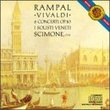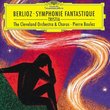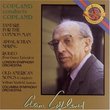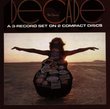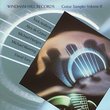| All Artists: Gustav Mahler, Jesús López-Cobos, Cincinnati Symphony Orchestra, Michelle DeYoung Title: Mahler: Symphony No. 3 Members Wishing: 1 Total Copies: 0 Label: Telarc Release Date: 11/24/1998 Genre: Classical Style: Symphonies Number of Discs: 2 SwapaCD Credits: 2 UPC: 089408048128 |
Search - Gustav Mahler, Jesús López-Cobos, Cincinnati Symphony Orchestra :: Mahler: Symphony No. 3
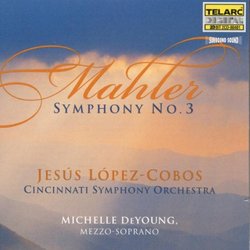 | Gustav Mahler, Jesús López-Cobos, Cincinnati Symphony Orchestra Mahler: Symphony No. 3 Genre: Classical
If there's any doubt at all that the Mahler renaissance is alive and well in middle America, then this recording should dispel any doubts. The Cincinnati Symphony--their brass section in particular-- clearly took this proj... more » |
Larger Image |
CD DetailsSynopsis
Amazon.com If there's any doubt at all that the Mahler renaissance is alive and well in middle America, then this recording should dispel any doubts. The Cincinnati Symphony--their brass section in particular-- clearly took this project as a challenge, and it sounds like they must have blown the music right off of their stands! Their playing is tremendous. I haven't heard trumpets and trombones having such a vulgar good time in the first movement since Bernstein's own first recording from the early 1960s. Not only does Lopez-Cobos pace the symphony ideally, he does the best fifth movement you'll ever hear. And Telarc captures it all in miraculously close and clear sound. The offstage trumpet in the third movement, especially, has never been better balanced. A triumph for all concerned. --David Hurwitz Similarly Requested CDs
|
CD ReviewsThe best recording of this work ever Douglas Beckerman | Sherman Oaks, California USA | 03/04/1999 (5 out of 5 stars) "For many years, the Horenstein/London Symphony recording of this work was considered the standard by which all others were to be matched. That late '60s performance suffered from dated acoustics and the ensemble not being in their prime years. Nonetheless, the fervor and commitment of both conductor and orchestra was very evident. It is still a serviceable rendering of the score. But what the Cincinnati Symphony under Lopez-Cobos have accomplished with this new release is truly astonishing. The interpretation (with the exception of the first few pages of the last movement, where the conductor seems to have lost his concentration) is exciting, intense and deeply involving. As for the playing...well, if one didn't know, you'd believe this was the Vienna or Berlin Philharmonic. Stupendous virtuosity in the brass and percussion and a truly world-class string section. The updated sonics now put this at the head of the class of the recordings of this rambling work. Who knew there was (beside the Cleveland Orchestra) another fabulous symphonic ensemble in Ohio? One can only hope Lopez-Cobos has started a complete Mahler cycle with this gem. A winner on all counts is this CD...Five Stars." Great Recording Douglas Beckerman | 09/24/1999 (5 out of 5 stars) "Lopez-Cobos and the CSO give a remarkable performance of this incredible work. It is exciting, beautiful, and moving. The CSO plays marvelously, especially in the brass and strings. My only complaint is that the horns were underrecorded and that the upper winds lack color in their more exposed parts. It's nice to hear a conductor really let the brass shine on the last chord as well. This disc would make a fine addition to any collection or a great introduction to a Mahler work." Possibly the Best Recording of This Symphony John A. League | Northern Virginia | 03/19/2004 (5 out of 5 stars) "Long have I quested after a Mahler 3 that carried off the power and almost otherworldly grandeur of the first movement, the deceptively simple (but not simplistic) build of the final movement, and the charming and bewitching character of each middle movement.This is that recording.Besides pleasing interpretation and pacing (read: the last movement does not turn into a dirge as it does in so many other versions), the playing of the Cincinnati Symphony is outstanding. Peter Norton's trombone solo in the first movement is doubtlessly the best available recorded version, and the section plays up to his standard throughout.And, lest we forget, there are Telarc's resplendent sonics. I have been a fan of the clean Telarc sound for years, but this is one of their best efforts, bringing off the warmth of Cincinnati's Music Hall quite well.An outstanding effort by all. Recommended without reservation."
|

 Track Listings (3) - Disc #1
Track Listings (3) - Disc #1